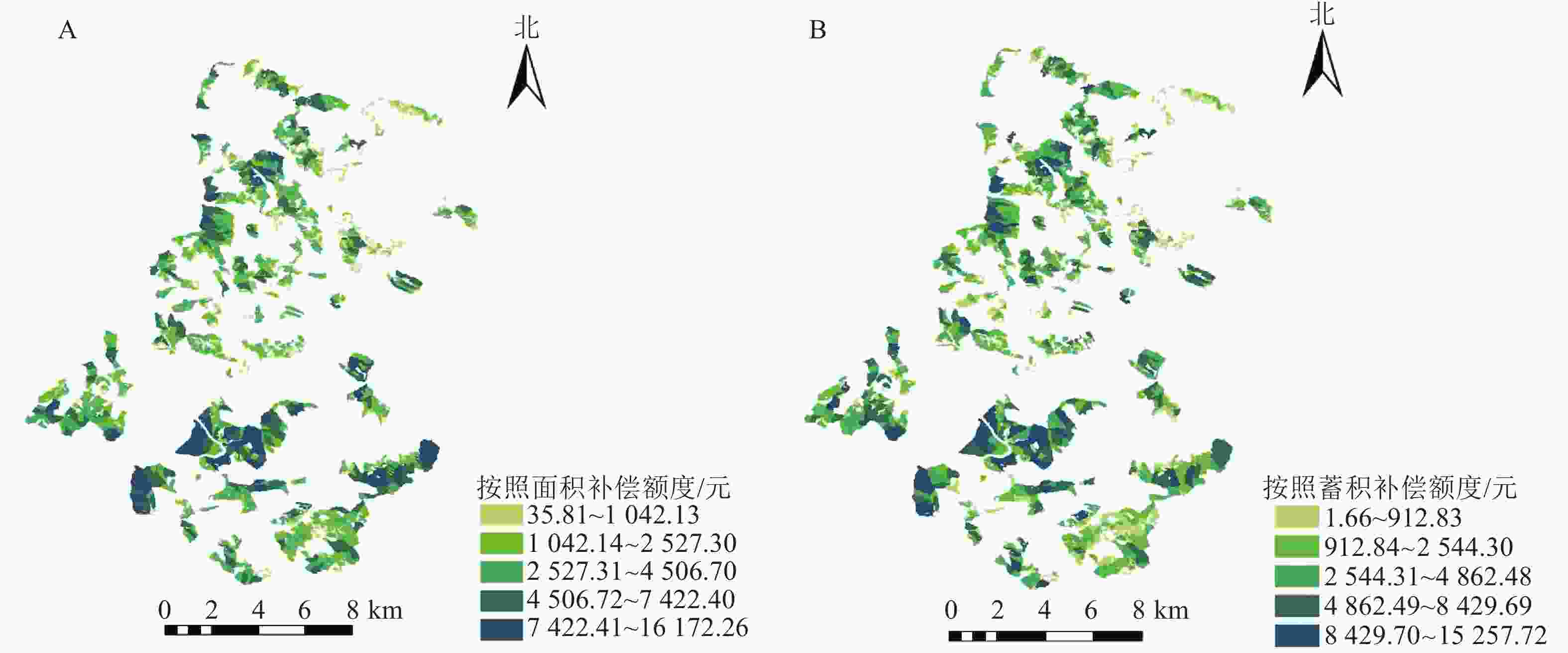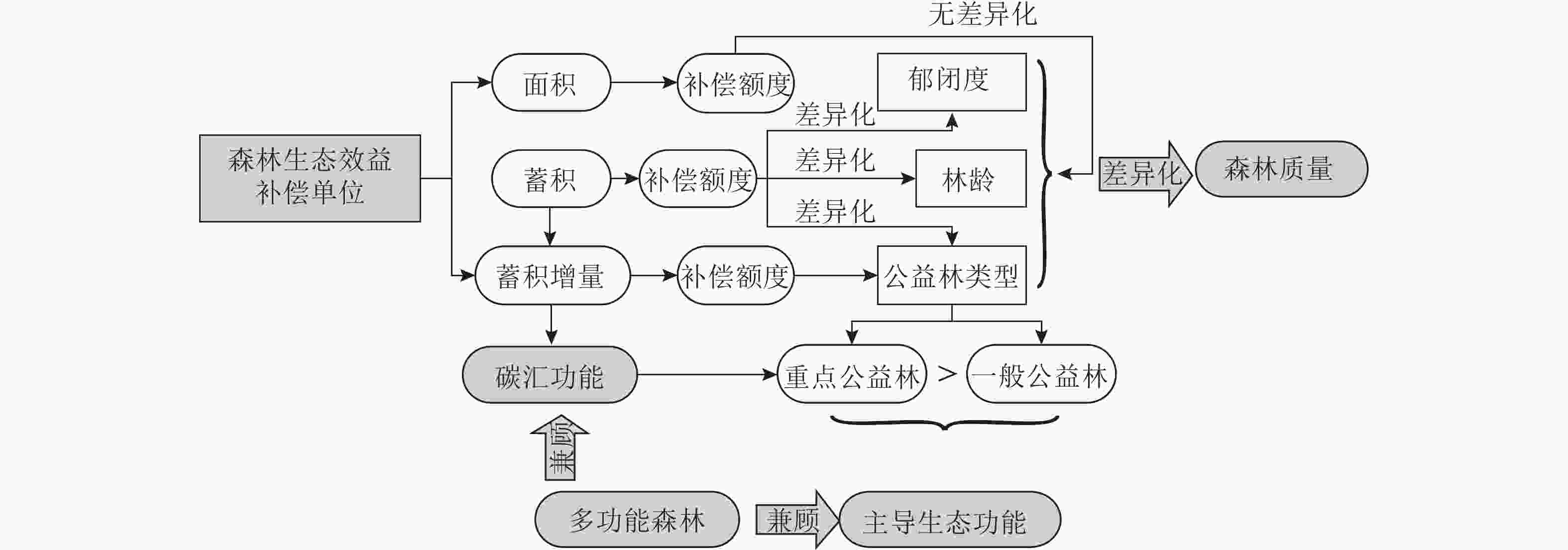-
公益林蓄积约占中国森林蓄积总量的67%,对森林生态服务功能和碳储功能贡献显著。然而公益林发挥的涵养水源、固碳释氧、生物多样性、保育土壤等多项森林生态服务功能大都以公共物品形式存在[1],森林生态服务价值的实现从理论转化为实践始终存在较大难点,森林生态效益难以有效转化为经济效益。森林生态效益补偿作为一种激励保护森林利益的协调机制[2],为维持公益林的生长提供了资金来源,一定程度上缓解了森林公共产品的外部性问题和市场供需失灵效应,是实现公益林生态服务价值的重要路径之一。公益林生态补偿问题也是制约公益林建设和实施分类经营的关键,因此完善森林生态效益补偿制度对于改善森林质量、提升生态服务能力具有重要意义。
国内外研究森林生态效益补偿量化的思路大体分为按照投入成本补偿、按照机会成本补偿、按照生态服务价值补偿和按照边际成本补偿。中国森林生态效益补偿倾向于“抑损性”思路的成本补偿,勉强维持公益林的经营,这与资金来源有限[3]、森林多种生态服务功能难以市场化有关。补偿标准低一直是公益林补偿的诟病。基于生态服务价值补偿理论认为应准确计量森林生态服务价值,然而依据全部生态服务价值进行补偿往往存在多种重复计算、缺乏经济学基础的问题[2],因而面临科学性不足和现实性资金的难题和障碍。一些学者进行了诸多量化补偿思路的探索,重点提倡考虑水源涵养、保育土壤、固碳释氧功能[4]或者主导生态功能[5]的价值进行补偿价值的量化,一定程度上为合理量化补偿额度提供了依据。不同空间范畴的一种或多种森林生态服务功能价值差异是考虑制定差异化补偿的一项重要依据,由于不同类型的森林在一定空间范畴和时空尺度上存在生物物理特征和环境条件的差异[6],森林的各项服务功能在空间上表现不同的分异特征。《森林生态系统服务功能评估规范》[7]采用分布式测算方式,重点考虑了森林树种、年龄、起源差异进行分类测算,并非将等面积的森林看作均等化的功能价值主体,而是构建差异化的森林生态服务价值量化方式。除森林起源、林龄、树种、疏密度等因素差异外,森林质量优劣也是补偿差异性考虑的重要因素。一些学者提出了“差异化补偿”[8−9],这些补偿思路为公益林生态补偿的公平分配构建了科学依据,指明了激励森林经营的方向。
目前采用的均衡化的面积补偿方式无法体现公益林经营效果差异,补偿标准也无法与森林质量、森林生态服务功能的价值挂钩[10],对于公益林经营主体提升生态功能的激励性不足。一些地区尝试依据生态区位、树种、林分质量、管护要求等要素构建差异化补偿方式,但这相当于对森林进行分级评价补偿,无法从根本上解决资金分配的倾向性。黄颖利等[11]提出重点公益林补偿单位应由森林面积转变为森林蓄积,体现公益林质量和效益上的差别,从而促进补偿的激励性、公平性。白冬艳[12]认为:依据森林蓄积为单位进行森林生态效益补偿相比面积单位能更好地促进森林质量提升,体现森林生态效益。森林生态效益补偿单位体现的是补偿资金分配的基本单元,可被视为衡量森林资源数量和质量的单位,应探索森林生态效益补偿更加合理的单位,促进森林生态效益补偿资金有效服务于森林经营与保护。
据此,本研究基于不同森林生态效益补偿单位对补偿资金的分配效果影响,论证合理的生态效益补偿单位对公益林生态服务功能和森林质量的关键作用,结合林业经营区划单位,从理论和实践角度分析评价不同的补偿单位对森林生态服务功能价值和森林质量差异性的影响效果。
-
森林作为一种自然资本,其已有资源的规模、结构和数量是存量,森林面积、森林蓄积属于森林生态资产的存量。森林碳储量是指森林生态系统中碳元素的储备量,是衡量森林固碳能力的指标,也属于存量概念。森林蓄积增量属于流量,森林碳汇量是指一定时间内所有碳库碳储量的变化量之和,也可表述为碳储增量,也属于流量。森林生态资产评估提倡存量和流量并重[13],公益林所发挥的生态效益是长期积累的结果,公益林生态效益补偿应在注重存量补偿价值分配的同时兼顾流量和增量的激励性补偿。存量补偿是实现按质补偿、差异化补偿的关键,增量补偿是森林生态效益补偿标准提升的着力点。尽管在碳中和目标下提倡以森林碳汇能力提升作为目标[14],森林碳汇能力提升的基础在于森林蓄积量的提升,蓄积作为存量是保证森林产生增量的重要依存,不能忽视森林经营者对现存森林的维护贡献。目前鲜有研究从存量和增量2个角度组合进行森林生态效益补偿单位的探索创新。本研究认为:公益林按照蓄积进行存量补偿、同时按照蓄积增量进行激励性补偿的思路(图1),既能满足森林质量提升的要求,又能促进森林从多角度实现碳汇价值的转化。
-
在当前造林空间有限的时代,增加森林尤其是公益林面积的难度加大,强调森林蓄积量提升要比提高森林面积更重要。森林单位面积蓄积量常被作为评价森林质量的重要指标,诸多研究表明蓄积增加与森林质量提升具有较强关联性,会积极影响森林生态服务能力和效益的发挥[6]。因此以森林蓄积量为着力点完善森林生态效益补偿制度能够促进森林生态服务功能的提升,基于蓄积进行补偿能够实现从均量补偿模式向“按质补偿”转变。“按质补偿”[15]是指根据森林质量好坏对森林实施差异化补偿,按照公平理论使林分质量好的公益林所有者得到更多经济补偿,这种补偿思路有利于促进公益林质量的提高[11]。蓄积作为森林生长因子之一,能够体现林分在生长和结构角度因树种、年龄、起源因素产生的差异,从而有效凸显森林生态功能差异化效果,与森林生态服务功能具有更强的关联性。森林年度蓄积量的变化会影响包括林木养分固持、碳储量等多种森林生态服务功能的变化。作为由森林生长累积形成的存量,蓄积能在时间维度上体现林分在生长过程中林龄的变化与积累,因此更适宜作为森林生态系统存量的评价单位。
-
森林蓄积增量是提升碳汇能力和生态系统服务的基础,蓄积增量既能反映森林质量提升,又能体现森林碳汇能力。由于蓄积量与森林碳储量呈现较强的正相关性[16],蓄积增量是森林碳汇量计算的重要依据,提升单位面积林分蓄积生长量被认为是未来中国碳汇量增加的着力点,森林活立木蓄积量的增长对碳储量密度存在较大影响[17]。诸多研究表明:采取适宜的森林抚育采伐措施能够促进森林碳汇能力[18],并且碳汇增长幅度随着森林经营管理水平的提升而加快,森林生态效益补偿基金是蓄积量提升效果明显的森林经营管理行为,对于促进森林碳汇服务等生态服务功能的提升则具有积极作用。公益林原本以水源涵养、防风固沙等功能作为主导功能,如能通过蓄积增量引导碳汇服务的提升,则需要探索以多功能经营目标为导向的公益林经营方式[19],将部分一般公益林按照《全国森林经营规划》 (2016—2050年)发展为“多功能兼用林”,采取适当的抚育采伐经营措施,兼顾提升蓄积增量和碳汇能力,同时以价值补偿更好地激励生态服务能力的提高。
生态服务流的观点促使一些学者[20]认为森林生态服务价值应该从流量角度进行量化,尤其是碳汇功能价值评价应该从蓄积增量或碳储增量角度进行量化,有学者认为可从边际效益的增量角度进行量化补偿[21]。蓄积增量作为单位新增森林资源产生边际效益的依据[21],更能体现森林生态服务价值的动态性和激励性。由于碳汇量数据的获取需要依据蓄积增量和碳计量参数计算,相对于碳汇数据,蓄积增量获取难度不大,因此作为补偿单位更具实践优势。目前增益性补偿主要激励森林提升生态服务能力尤其是碳汇功能,可将碳汇价值纳入生态补偿体系[22],对于森林生态服务功能具有更强的激励性,同时能拓宽补偿资金来源。
-
以浙江省淳安县临岐镇公益林为研究对象。浙江省淳安县地处浙江省西部, 29°11′~30°02′N, 118°20′~119°20′E,是国家5A级风景区千岛湖所在地,森林资源丰富,是浙江省生态公益林面积最大的县,现有公益林16.65 万hm2,发挥着重要的生态屏障作用。2020年全县公益林生态总效益达275.23亿元[23]。淳安县现行实施的森林生态效益补偿方案为基于面积的资金分配方式,仅针对重点公益林和一般公益林采取差异化补偿标准。2021年起,淳安县设立特别生态功能区森林生态效益市级补偿资金,对市级及以上公益林实行统一补偿标准。
-
采用2017、2019年淳安县森林资源二类调查数据和淳安县公益林生态效益补偿标准数据进行评价与分析,根据森林资源二类调查数据获取临岐镇范围内公益林的小班调查因子,包括面积、蓄积、林龄、郁闭度等因子。从淳安县森林资源二类调查数据属性信息可知,淳安县公益林大多属于水源涵养林。森林涵养水源功能主要与林龄、林分疏密度和林型有关,森林涵养水源功能随着林龄增大而增强,且郁闭度越高的林分涵养水源功能也越高[24]。为了凸显不同因子对森林生态功能产生的差异,分别针对公益林林龄、郁闭度、公益林类型进行补偿分级统计与效果对比(图2),重点对比公益林按照面积和蓄积补偿的分级效果,分析差异化补偿的合理性,同时比对2017—2019年临岐镇公益林蓄积增长量在不同公益林类型、不同龄组之间的差异效果,分析依据蓄积增量构建激励性补偿的可能性。
-
2019年,临岐镇的公益林面积为5 397.18 hm2(去除数据中林木蓄积为0、活立木蓄积为0的森林小班),若按2019年浙江省国家公益林实施的525元·hm−2的补偿标准计算补偿总额,将补偿总额根据所有小班蓄积总量进行分配,重新计算补偿额度和标准,可得到每个小班按照蓄积补偿的额度以及每个小班单位面积的蓄积补偿额度。表1显示了临岐镇不同类型公益林按照面积和蓄积单位分配资金的不同补偿效果,由于该区域重点公益林比一般公益林的单位面积蓄积量要大一些,原则上重点公益林补偿额度也应多一些,可以看出:采用按照蓄积补偿的结果比按照面积补偿的结果更能体现重点公益林森林质量好于一般公益林的情况。
表 1 2019年临岐镇公益林按照面积和蓄积单位补偿结果
Table 1. Ecological forest compensation results allocated by area unit and volume unit of Linqi Town in 2019
公益林类型 面积/hm2 公益林蓄积/m3 单位面积蓄积/(m3·hm−2) 面积补偿额度/元 蓄积补偿额度/元 重点公益林 5 020.55 384 622.14 76.6 2 635 792 2 648 715 一般公益林 376.63 26 835.71 71.3 197 729 184 806 合计 5 397.18 411 457.85 76.2 2 833 521 2 833 521 说明:2019年浙江省国家公益林补偿标准为525 元·hm−2。蓄积补偿标准为6.887 元·m−3。 -
统计分析基于面积单位和蓄积单位在不同林龄和不同郁闭度公益林的补偿额度结果(表2和表3):单位面积的蓄积单位补偿额度从大到小依次为过熟林、成熟林、近熟林、中龄林、幼龄林,这与林龄对森林涵养水源功能的影响一致,说明按照蓄积补偿能够满足林龄差异产生的森林生态服务价值差异;郁闭度越大的森林得到的单位面积补偿额度越大。以上结果表明:以蓄积为补偿单位能够体现出年龄差异、林分密度差异,一定程度上也能体现出森林生态服务功能和森林质量优劣。
表 2 2019年临岐镇公益林按照林龄评价面积补偿和蓄积补偿结果
Table 2. Ecological forest compensation results allocated by area unit and volume unit which distinguished by the forest age group of Linqi Town in 2019
龄组 小班数量 面积/hm2 蓄积/m3 面积补偿额度/元 蓄积补偿额度/元 单位面积蓄积补偿额度/(元·hm−2) 幼龄林(1) 505 2 552.95 154 641.40 1 340 300 1 064 946 417.14 中龄林(2) 528 1 189.79 93 153.58 624 640 641 507 539.18 近熟林(3) 272 780.43 71 806.99 409 723 494 502 633.63 成熟林(4) 197 671.87 69 020.74 352 733 475 314 707.45 过熟林(5) 49 202.14 22 835.14 106 125 157 252 777.93 合计 1 551 5 397.18 411 457.85 2 833 521 2 833 521 表 3 2019年临岐镇公益林按照郁闭度分级评价面积补偿和蓄积补偿结果
Table 3. Ecological forest compensation results allocated by area unit and volume unit which distinguished by canopy density of Linqi Town in 2019
郁闭度 小班数量 面积/hm2 蓄积/m3 面积补偿额度/元 蓄积补偿额度/元 单位面积的蓄积补偿额度/(元·hm−2) 0.20~0.49 246 323.58 6 835.11 169 877 47 070 145.47 0.50~0.69 489 1 448.98 78 946.04 760 716 543 665 375.20 0.70~0.79 501 2 078.37 165 522.20 1 091 145 1 139 876 548.45 >0.80 315 1 546.25 160 154.52 811 783 1 102 910 713.28 合计 1 551 5 397.18 411 457.85 2 833 521 2 833 521 -
图3为2019年临岐镇以面积为补偿单位和以蓄积为补偿单位的小班补偿额度的差异。基于面积补偿结果中补偿额度最大值的小班单位面积蓄积为71.10 m3·hm−2。基于蓄积补偿结果中补偿额度最大值的小班单位面积蓄积为142.65 m3·hm−2,单位面积蓄积量更加突出。相对而言,按照蓄积为单位进行补偿的结果更能体现“优质优价”原则,不同小班之间补偿差异更大,但更能体现森林质量差异。

图 3 2019年临岐镇公益林小班尺度按照面积补偿的额度(A)和按照蓄积补偿的额度(B)对比效果
Figure 3. Effect of ecological forest compensation according to area unit (A) and volume unit (B) at small class scale of Linqi Town in 2019
将不同补偿单位的小班补偿额度按照面积进行标准化处理,以表示不同小班之间补偿密度差异。由图4可见: 按照面积补偿是不区分森林优劣的。如按照蓄积补偿,每个小班补偿额度取决于其蓄积量大小,通过单位面积补偿额度大小之间差异体现出森林的优劣评价。

图 4 2019年临岐镇公益林按照面积补偿的单位面积效果(A)和按照蓄积补偿的单位面积效果(B)
Figure 4. Effect of ecological forest compensation per unit area according to area unit (A) and volume unit (B) of Linqi Town in 2019
为了得到蓄积增量,将2017和2019年临岐镇森林小班数据做对比差分,得到公益林(去除蓄积和增量0值小班后)各龄组蓄积增量和单位面积蓄积增量。重点公益林的单位面积蓄积增量(7.185 m3·hm−2)大于一般公益林单位面积蓄积增量(2.775 m3·hm−2)。由表4得出:幼龄林单位面积蓄积增量最大,大于所有小班单位面积蓄积增量平均值,其他龄组的单位面积蓄积增量差异不明显。这表明临岐镇幼龄林阶段的碳汇潜力要更强一些,这与浙江省总体增汇效果贡献较大的乔木中幼林占主导的情况比较吻合,中幼龄林处于快速生长阶段,具有较高的固碳速率和较大的碳汇增长潜力。根据2017—2019年全部小班蓄积增量(21 681.0 m3),按照单位森林蓄积固碳1.83 t·m−3[25]计算,临岐镇2 a间森林新增固碳约39 676.0 t。
表 4 2017—2019年临岐镇公益林各龄组蓄积增量和单位面积蓄积增量
Table 4. Volume increment and per unit area volume increment of ecological forest according to age group in Linqi Town from 2017 to 2019
龄组 面积/hm2 2017—2019年
蓄积增量/m3单位面积蓄积
增量/(m3·hm−2)幼龄林(1) 1 141.73 10 834.2 9.49 中龄林(2) 1 258.56 5 985.4 4.76 近熟林(3) 517.44 2 615.1 5.05 成熟林(4) 334.12 1 852.0 5.54 过熟林(5) 70.89 394.4 5.56 合计 3 322.74 21681.0 6.53 -
本研究针对现有基于面积补偿的森林生态效益补偿方式在资金分配的公平性、生态服务功能的激励性方面存在的局限性,从森林生态系统存量和增量视角提出了基于蓄积为存量补偿单位的方式和基于蓄积增量为“激励性”补偿单位的方式。认为基于蓄积为补偿单位能够弥补当前基于面积补偿的均衡化补偿模式的不足,有助于实现“按质补偿”和“差异化补偿”,从而凸显森林质量和森林生态服务功能;基于蓄积增量为“激励性”补偿单位的方式能够贴合碳汇目标需求,激励采用多功能经营方式促进碳汇功能等生态功能的提升。
本研究以浙江省淳安县临岐镇公益林为案例,依据当前森林生态效益补偿执行标准计算了公益林按照面积和蓄积补偿对不同森林资源调查因素的评价结果,体现了蓄积相对于面积补偿在凸显公益林主导生态功能方面的优势。结果表明:采用蓄积单位方式的补偿资金分配效果能够对研究区域主导的水源涵养功能和森林质量进行科学分级评价,即体现不同小班之间水源涵养功能差异和森林质量差异,符合“按质补偿”的思路。由于不具备核算水源涵养等生态服务功能价值的详细数据,本研究是通过补偿资金按照蓄积分配的结果分别对公益林类型、林龄、郁闭度进行分级分析,结果符合已有研究核算的浙江省淳安县水源涵养功能价值占主导地位的现实情况[26]。本研究采用按照蓄积补偿的结果更能体现重点公益林生态服务功能优于一般公益林的效果,在不同林龄公益林按照蓄积补偿能够体现林龄对森林涵养水源功能的影响。按照蓄积补偿能够使郁闭度越大的森林得到的补偿额度越大,这与郁闭度对森林涵养水源功能的影响也是一致的[24]。按照面积为单位进行补偿,单位面积的补偿额度都是均等的,体现不出单位面积蓄积这个衡量森林质量的重要因子的差异。而按照蓄积补偿的单位面积补偿额度不同,则能体现森林质量优劣。通过分析2017—2019年森林蓄积增量评价不同年龄的森林蓄积增量水平,以此作为基于增量补偿的依据,结合蓄积增量与碳汇的量化关系,认为基于蓄积增量的补偿能够有效体现碳汇功能,实现兼顾森林水源涵养功能和碳汇功能的多功能经营[27]需求。但由于数据精细程度的限制,本研究并未对森林碳汇量进行测算,只是大体评估了蓄积增量作为碳汇激励性补偿的可行性,重点放在通过理论对蓄积增量补偿思路的必要性进行论证,下一步仍需对基于蓄积增量作为补偿单位的实践性进行深入研究。
本研究提出将蓄积增量作为激励性的补偿单位,是考虑到采用蓄积增量作为普遍性的补偿单位仍存在一定的普适性问题和难度,如果只以蓄积增量为单位进行补偿忽视了森林生态系统存量部分的贡献,可能会弱化重点公益林原本经营的生态服务功能,因此蓄积增量更适用于作为森林生态效益“增益性”补偿的单位。另外,根据碳汇核算办法,新造林和已有森林的蓄积增长量的基准年限不同,难以将两者的增量及其产生的森林生态服务价值进行比对。因此,以增量作为森林生态效益补偿单位需要建立在存量补偿的基础上,兼顾两者是非常重要的。本研究的理论贡献在于基于森林生态服务功能探索了从存量和增量2个维度进行补偿的思路,是针对传统基于面积存量补偿的不足和诸多基于增量的创新思路局限性的完善与补充,一方面将补偿效果指明森林生态服务价值和森林质量,促进“按质补偿”,另一方面通过增益性补偿思路引导实现激励性补偿。在实际执行补偿中还需探索如何根据不同的补偿资金来源,结合补偿主体对生态系统服务的补偿意愿完善更精细化的补偿分配制度。此外考虑到全国各省份不同林区之间森林生长速度差异和树种差异,按照蓄积补偿的额度还需要根据各地公益林资源总体状况和生长状况进行确定。
碳汇目标对森林经营既是挑战又是机遇,对于森林已有的经营目标同时兼顾碳汇服务的需求,则需考虑将部分公益林作为实施多功能经营的主体,同时也需要考虑森林生态服务之间的权衡[28]和协同关系。此外,实施激励性补偿在现行政府补偿资金来源模式下可能存在一定的障碍,也需要森林碳汇价值通过市场化资金进行补偿或者价值转化,逐步引导社会资本和各种社会主体参与森林生态效益补偿,通过开发森林碳汇类生态产品等扩充补偿资金来源。
Using volume and volume increment as units of payment for ecosystem services based on ecological public forest
-
摘要:
目的 森林生态效益补偿单位的转变是促进公益林质量提升和激励森林生态服务功能提升的需要。通过合理设置多元化的森林生态效益补偿单位,促进补偿资金的科学分配,实现对公益林生态服务价值的差异化合理评价。 方法 基于森林生态系统存量和增量的视角和特点,探索多元化的补偿单位,提出了以蓄积为单位实施存量补偿以促进森林生态效益“按质补偿”、以蓄积增量为单位实施“激励性”的增量补偿以促进森林碳汇能力提升的补偿思路。以浙江省淳安县临岐镇公益林为案例,基于现有森林区划的最小单位——小班分析评价了公益林生态效益补偿以蓄积和蓄积增量作为补偿单位的可行性。 结果 按照蓄积补偿比按照面积补偿更能凸显森林水源涵养功能和森林质量的“差异化”补偿效果;以蓄积增量为单位能够促进对碳汇功能的兼顾改善,满足森林生态服务多功能经营目标需求。 结论 以蓄积和蓄积增量为补偿单位组合实施公益林生态效益补偿,能够有效维护现有森林生态系统存量,同时激励森林生态系统增量的扩张,弥补面积单位在当前公益林生态效益补偿中价值体现激励性、动态性不足的问题,为有效促进森林生态服务功能指明提升方向。图4表4参28 Abstract:Objective Transforming the unit of forest payments for ecosystem services is the requirement for promoting the quality of ecological public forests and stimulating the enhancement of forest ecological services. There is an urgent demand for the theory and academic aspects to improve the method of payments funds allocation scientifically through diversified units of forest payments for ecosystem services, which can evaluate the different ecological service value of ecological public forests reasonably. Method Based on the scope and characteristic of forest ecosystems accumulation and increment, we explored diversified units of payments for forest ecosystem services, and propose the idea that forest ecosystems accumulation compensation in terms of volume unit which can promote “compensation by quality” for forest ecological benefits, and “incentive” compensation in terms of volume increment unit which can promote the enhancement of forest carbon sink capacity. Taking the ecological public forest in Linqi Town, Chun’an County, Zhejiang Province as a case, this paper analyzed and evaluated the feasibility of ecological public forest payments funds allocation using volume unit and volume increment unit based on the smallest forest division unit - small class. Result Using volume as unit of ecological public forest payments is more effective than that of area, which could highlight the differentiation of forest water-holding function and forest quality. Payments using volume increment as unit could promote improvement of carbon sink function, which met the requirements of multi-functional management of forest ecological services. Conclusion Implementing payments of ecological public forests using volume unit combined with volume increment unit could effectively maintain the existing forest ecosystem stock and stimulate the of forest ecosystem increment, which can make up for the inability of area unit on value incentive and dynamics in the current payments for public forest ecosystem services, and point out the direction of improvement for forest management to effectively promote ecological services. [Ch, 4 fig. 4 tab. 28 ref.] -
Key words:
- ecological public forest /
- payments for ecosystem services /
- unit /
- volume /
- volume increment
-
表 1 2019年临岐镇公益林按照面积和蓄积单位补偿结果
Table 1. Ecological forest compensation results allocated by area unit and volume unit of Linqi Town in 2019
公益林类型 面积/hm2 公益林蓄积/m3 单位面积蓄积/(m3·hm−2) 面积补偿额度/元 蓄积补偿额度/元 重点公益林 5 020.55 384 622.14 76.6 2 635 792 2 648 715 一般公益林 376.63 26 835.71 71.3 197 729 184 806 合计 5 397.18 411 457.85 76.2 2 833 521 2 833 521 说明:2019年浙江省国家公益林补偿标准为525 元·hm−2。蓄积补偿标准为6.887 元·m−3。 表 2 2019年临岐镇公益林按照林龄评价面积补偿和蓄积补偿结果
Table 2. Ecological forest compensation results allocated by area unit and volume unit which distinguished by the forest age group of Linqi Town in 2019
龄组 小班数量 面积/hm2 蓄积/m3 面积补偿额度/元 蓄积补偿额度/元 单位面积蓄积补偿额度/(元·hm−2) 幼龄林(1) 505 2 552.95 154 641.40 1 340 300 1 064 946 417.14 中龄林(2) 528 1 189.79 93 153.58 624 640 641 507 539.18 近熟林(3) 272 780.43 71 806.99 409 723 494 502 633.63 成熟林(4) 197 671.87 69 020.74 352 733 475 314 707.45 过熟林(5) 49 202.14 22 835.14 106 125 157 252 777.93 合计 1 551 5 397.18 411 457.85 2 833 521 2 833 521 表 3 2019年临岐镇公益林按照郁闭度分级评价面积补偿和蓄积补偿结果
Table 3. Ecological forest compensation results allocated by area unit and volume unit which distinguished by canopy density of Linqi Town in 2019
郁闭度 小班数量 面积/hm2 蓄积/m3 面积补偿额度/元 蓄积补偿额度/元 单位面积的蓄积补偿额度/(元·hm−2) 0.20~0.49 246 323.58 6 835.11 169 877 47 070 145.47 0.50~0.69 489 1 448.98 78 946.04 760 716 543 665 375.20 0.70~0.79 501 2 078.37 165 522.20 1 091 145 1 139 876 548.45 >0.80 315 1 546.25 160 154.52 811 783 1 102 910 713.28 合计 1 551 5 397.18 411 457.85 2 833 521 2 833 521 表 4 2017—2019年临岐镇公益林各龄组蓄积增量和单位面积蓄积增量
Table 4. Volume increment and per unit area volume increment of ecological forest according to age group in Linqi Town from 2017 to 2019
龄组 面积/hm2 2017—2019年
蓄积增量/m3单位面积蓄积
增量/(m3·hm−2)幼龄林(1) 1 141.73 10 834.2 9.49 中龄林(2) 1 258.56 5 985.4 4.76 近熟林(3) 517.44 2 615.1 5.05 成熟林(4) 334.12 1 852.0 5.54 过熟林(5) 70.89 394.4 5.56 合计 3 322.74 21681.0 6.53 -
[1] MORGAN E A, BUCKWELL A, GUIDI C, et al. Capturing multiple forest ecosystem services for just benefit sharing: the basket of benefits approach [J]. Ecosystem Services, 2022, 11(6): 1 − 21. [2] 马浩然, 赵天忠. 森林生态效益补偿研究进展与展望[J]. 北京林业大学学报(社会科学版), 2021, 20(4): 90 − 99. MA Haoran, ZHAO Tianzhong. Research of forest ecological benefit compensation: progress and prospect [J]. Journal of Beijing Forestry University (Social Sciences), 2021, 20(4): 90 − 99. [3] 刘明明, 卢群群, 杨纪超. 论中国森林生态效益补偿制度存在的问题及完善[J]. 林业经济问题, 2018, 38(5): 1 − 9. LIU Mingming, LU Qunqun, YANG Jichao. Problems and improvement of compensation system for forest ecological benefits in China [J]. Issues of Forestry Economics., 2018, 38(5): 1 − 9. [4] 吴强, PENG Yuanying, 马恒运, 等. 森林生态系统服务价值及其补偿校准——以马尾松林为例[J]. 生态学报, 2019, 39(1): 117 − 130. WU Qiang, PENG Yuanying, MA Hengyun, et al. Research on the value of forest ecosystem services and compensation in a Pinus massoniana forest [J]. Acta Ecologica Sinica, 2019, 39(1): 117 − 130. [5] 牛香. 森林生态效益分布式测算及其定量化补偿研究[D]. 北京: 北京林业大学, 2012. NIU Xiang. Research on Distributed Assessment and Quantitative Compensation of Forest Ecological Benefits [D]. Beijing: Beijing Forestry University, 2012. [6] 韩皓爽, 万荣荣. 森林生态质量评估方法研究进展[J]. 生态科学, 2021, 40(4): 212 − 222. HAN Haoshuang, WAN Rongrong. A review on the methods of ecological evaluation of forest quality [J]. Ecological Science, 2021, 40(4): 212 − 222. [7] 国家林业和草原局. 森林生态系统服务功能评估规范: GB/T38582—2020[S]. 北京: 中国标准出版社, 2020. State Forestry and Grassland Administration. Specification for Forest Ecosystem Service Function Assessment GB/T 38582−2020[S]. Beijing: Standards Press of China, 2020. [8] 陈臻, 石程远, 边更战, 等. 生态公益林分级补偿研究——以株洲市为例[J]. 林业资源管理, 2015(5): 44 − 49. CHEN Zhen, SHI Chengyuan, BIAN Gengzhan, et al. Study on graded compensation for ecological forests in Zhuzhou [J]. Forest Resources Management, 2015(5): 44 − 49. [9] 盛文萍, 甄霖, 肖玉. 差异化的生态公益林生态补偿标准——以北京市为例[J]. 生态学报, 2019, 39(1): 45 − 52. SHENG Wenping, ZHEN Lin, XIAO Yu. Distinct eco-compensation standards for ecological forests in Beijing [J]. Acta Ecologica Sinica, 2019, 39(1): 45 − 52. [10] 于丽瑶, 石田, 郭静静. 森林生态产品价值实现机制构建[J]. 林业资源管理, 2019(6): 28 − 31. YU Liyao, SHI Tian, GUO Jingjing. Developing mechanisms to realize the value of forest ecological products [J]. Forest Resources Management, 2019(6): 28 − 31. [11] 黄颖利, 关赢, 秦会艳. 重点公益林生态补偿依据从面积到蓄积的转变[J]. 浙江农林大学学报, 2022, 39(1): 199 − 206. HUANG Yingli, GUAN Ying, QIN Huiyan. Change in the basis of ecological compensation for key public welfare forests from area to volume [J]. Journal of Zhejiang A&F University, 2022, 39(1): 199 − 206. [12] 白冬艳. 多功能森林经营效益优化及财政政策调控研究[D]. 沈阳: 沈阳农业大学, 2013. BAI Dongyan. Research on Optimal Benefit of Multiple Function Forest Management and Fiscal Policy [D]. Shenyang: Shenyang Agricultural University, 2013. [13] 姜紫薇. 森林生态资产价值核算与实现路径研究[D]. 衡阳: 南华大学, 2021. JIANG Ziwei. Research on Value Accounting and Realization Path of Forest Ecological Assets [D]. Hengyang: University of South China, 2021. [14] 周国模, 邱亦维, 徐林. 碳中和: 基于林业的解决路径研究[J]. 特区实践与理论, 2021(5): 37 − 44. ZHOU Guomo, QIU Yiwei, XU Lin. Carbon neutralization: research on the solution path based on forestry [J]. Practice and Theory of SEZS, 2021(5): 37 − 44. [15] 温作民. 略论森林生态效益补偿资金的有效使用[J]. 林业经济, 2001, 23(11): 16 − 18. WEN Zuomin. The effective use of forest ecological benefit compensation funds [J]. Forestry Economics, 2001, 23(11): 16 − 18. [16] 张颖, 李晓格, 温亚利. 碳达峰碳中和背景下中国森林碳汇潜力分析研究[J]. 北京林业大学学报, 2022, 44(1): 38 − 47. ZHANG Ying, LI Xiaoge, WEN Yali. Carbon sink potential of beijing’s forest under carbon peak and carbon neutrality [J]. Journal of Beijing Forestry University, 2022, 44(1): 38 − 47. [17] 杜之利, 苏彤, 葛佳敏, 等. 碳中和背景下的森林碳汇及其空间溢出效应[J]. 经济研究, 2021, 56(12): 187 − 202. DU Zhili, SU Tong, GE Jiamin, et al. Forest carbon sink and its spatial spillover effect in the context of carbon neutrality [J]. Economic Research Journal, 2021, 56(12): 187 − 202. [18] 周一凡, 刘烁华, 姚顺波, 等. 森林碳汇对森林经营强度响应的元分析[J]. 林业经济, 2021, 43(11): 12 − 25. ZHOU Yifan, LIU Shuohua, YAO Shunbo, et al. A Meta-analysis of the response of forest carbon sinks to forest management intensity [J]. Forestry Economics, 2021, 43(11): 12 − 25. [19] 黄麟. 森林管理的生态效应研究进展[J]. 生态学报, 2021, 41(10): 4226 − 4239. HUANG Lin. Research progress on ecological effects of forest management [J]. Acta Ecologica Sinica, 2021, 41(10): 4226 − 4239. [20] ZHANG Linbo, HAO Chaozhi, SONG Yang, et al. Basic principles of gross ecosystem product (GEP) accounting [J]. Journal of Resources and Ecology, 2022, 13(3): 501 − 510. [21] 聂承静, 程梦林. 基于边际效应理论的地区横向森林生态补偿研究——以北京和河北张承地区为例[J]. 林业经济, 2019, 41(1): 24 − 31. NIE Chengjing, CHENG Menglin. Research on regional lateral forest ecological compensation based on the theory of marginal effect [J]. Forestry Economics, 2019, 41(1): 24 − 31. [22] 赵荣钦, 黄贤金, 郧文聚, 等. 碳达峰碳中和目标下自然资源管理领域的关键问题[J]. 自然资源学报, 2022, 37(5): 1123 − 1136. ZHAO Rongqin, HUANG Xianjin, YUN Wenju, et al. Key issues in natural resource management under carbon emission peak and carbon neutrality targets [J]. Journal of Natural Resources, 2022, 37(5): 1123 − 1136. [23] 淳安县林业局. 杭州市林水局到淳安会商生态公益林补偿工作[EB/OL]. 2022-08-05[2023-01-05]. http://lyj.zj.gov.cn/art/2020/8/5/art_1294331_54038867.html. Chun’an Forestry Bureau. Hangzhou Forestry and Water Bureau Discuss Ecological Public Forests Compensation Work in Chun’an [EB/OL]. 2022-08-05 [2023-01-05]. http://lyj.zj.gov.cn/art/2020/8/5/art_1294331_54038867.html. [24] 王升堂, 孙贤斌, 夏韦, 等. 生态系统水源涵养功能的重要性评价——以皖西大别山森林为例[J]. 资源开发与市场, 2019, 35(10): 1252 − 1257. WANG Shengtang, SUN Xianbin, XIA Wei, et al. Evaluating on significance function of water conservation in forest ecosystem-taking Dabieshan Mountain in western Anhui Province as an example [J]. Resource Development &Market, 2019, 35(10): 1252 − 1257. [25] 刘健, 王逸群, 杨奇. 淳安成立森林碳汇管理局: 全域乡镇都有“碳管家”[N/OL]. 浙江日报, 2022-09-10[2023-01-05]. https://zjnews.zjol.com.cn/zjnews/202209/t20220910_24781163.shtml. LIU Jian, WANG Yiqun, YANG Qi. Forest carbon sink management bureau was established in Chun’an, all towns and townships have “Carbon Stewards”[N/OL]. Zhejiang Daily, 2022-09-10[2023-01-05]. https://zjnews.zjol.com.cn/zjnews/202209/t20220910_24781163.shtml. [26] 相晨, 严力蛟, 韩轶才, 等. 千岛湖生态系统服务价值评估[J]. 应用生态学报, 2019, 30(11): 3875 − 3884. XIANG Chen, YAN Lijiao, HAN Yicai, et al. Evaluation of ecosystem services of the Thousand Island Lake, Zhejiang, China [J]. Chinese Journal of Applied Ecology, 2019, 30(11): 3875 − 3884. [27] MARTES L, KÖHL M. Improving the contribution of forests to carbon neutrality under different policies: a case study from the Hamburg Metropolitan Area [J]. Sustainability, 2022, 14(21): 1 − 17. [28] KANGAS J, OLLIKAINEN M. A PES scheme promoting forest biodiversity and carbon sequestration [J/OL]. Forest Policy and Economics, 2022, 136: 102692[2023-01-07]. doi: 10.1016/j.forpol.2022.102692. -

-
链接本文:
https://zlxb.zafu.edu.cn/article/doi/10.11833/j.issn.2095-0756.20230026







 下载:
下载:



